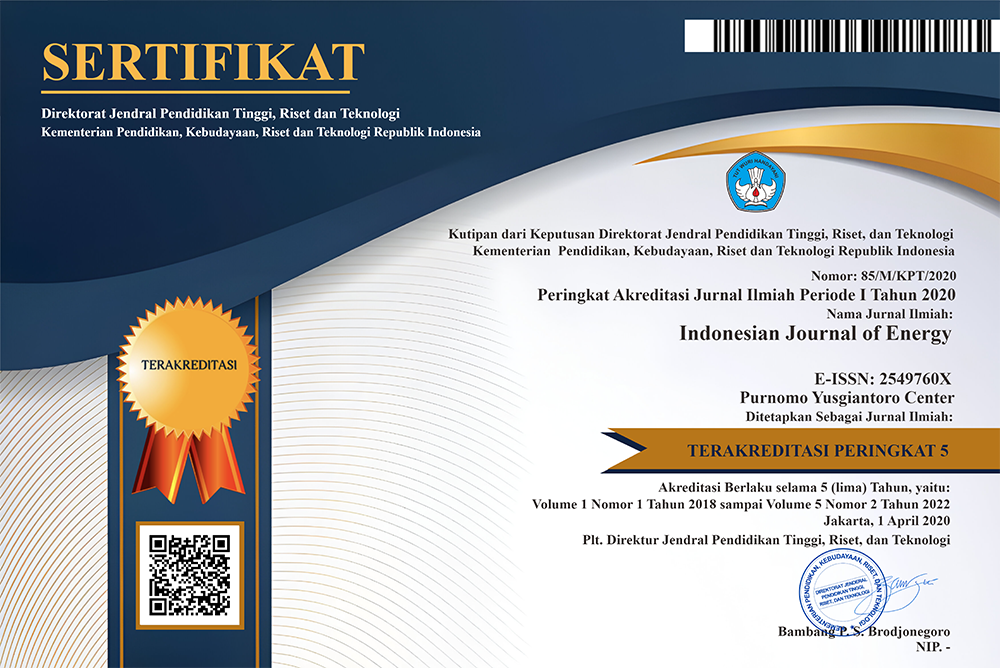Security–Energy Nexus in Indonesia’s Border: The Case of Natuna
Abstract
Natuna is one of the outmost islands in northern Indonesia. Natuna is vital as it delimits Indonesia’s territorial and deposits abundant energy resources. However, Natuna is also vulnerable, as it is adjacent to (and is partly located in) the South China Sea, a flash point in the region. As the sea is rich in natural resources, many countries around the sea are competing to control it, which leads to disputes. This study combines a literature review with interviews and finds that the risk of threats in the Natuna area encourages Indonesia to establish a military base there. The military base plays a role in securing Indonesia’s sovereignty over the Natuna area, including energy resources, an essential resource for the economy and development. This study proposes a new notion of ‘energy resource effects’ that influence the development of the situation and Indonesia’s decision to build a military base in the Natuna area. The energy-security nexus, thus, implies the close relationships between energy and security and how the two affect each other. Finally, this study also offers Indonesia’s perspective on securing its border areas, especially those rich in energy resources.
Downloads
References
Adamczyk, M., & Rutkowska, P. (2018). China on the road to becoming a sea power - Is this the renaissance of A.T. Mahan’s and J.S. Corbett’s theory? Kultura - Historia - Globalizacja, 23, 1–16.
Afful-Dadzie, A., Afful-Dadzie, E., Awudu, I., & Banuro, J. K. (2017). Power generation capacity planning under budget constraint in developing countries. Applied Energy, 188, 71–82. https://doi.org/10.1016/j.apenergy.2016.11.090
Asri, N. D., Legowo, E. H., & Yusgiantoro, P. (2024). The impact of the pandemic on environmental health from the perspective of energy sector. International Journal of Public Health Science, 13(1), 282–293. http://doi.org/10.11591/ijphs.v13i1.23027
Asri, N. D., & Yusgiantoro, P. (2020). The energy provision dilemma of coal versus wind from the economic, environmental, and social perspective within the energy security framework. Defense Journal, 6(3), 310–327. https://doi.org/10.33172/jp.v6i3.1049
Asri, N. D., & Yusgiantoro, P. (2021a). Investigating a hampered NRE utilization in Kaltim’s energy system: Is there an energy policy with a syndrome of the energy-abundant area? International Journal of Renewable Energy Development, 10(4), 653–666. https://doi.org/10.14710/ijred.
37135
Asri, N. D., & Yusgiantoro, P. (2021b). Is sustainability challenging in Indonesia’s energy provision? - Fuel type vs externalities in electricity cost analysis. Sustinere Journal of Environment & Sustainability, 5(2), 103–132. https://doi.org/10.22515/sustinere.jes.v5i2.154
Asri, N. D., & Yusgiantoro, P. (2022a). A revisit of the energy-economy-environment nexus with multi-regression. International Journal on Advanced Science, Engineering and Information Technology, 12(5), 1866–1874. https://doi.org/10.18517/ijaseit.12.5.15907
Baumert, K., & Melchior, B. (2014). Limits in the seas (143; Issue 143).
Best, R., & Burke, P. J. (2018). Electricity availability: A precondition for faster economic growth? Energy Economics, 74, 321–329. https://doi.org/10.1016/j.eneco.2018.06.018
Budiana, M., Fedryansyah, M., Djuyandi, Y., & Pancasilawan, R. (2019). Indonesia military power under the increasing threat of conflict in the South China Sea. Central European Journal of International and Security Studies, 13(4), 259–274. https://www.cejiss.org/indonesia-military-power-under-the-increasing-threat-of-conflict-in-the-south-china-sea
Buszynski, L., & Sazlan, I. (2007). Maritime claims and energy cooperation in the south China sea. Contemporary Southeast Asia, 29(1), 143–171. https://doi.org/10.1355/cs29-1g
Cáceres, S. B. (2013). Understanding China’s global search for energy and resources. Central European Journal of International and Security Studies, 7(1), 40–59. https://doi.org/10.4324/9781315879338-9
Chan, G. (2015). China eyes ASEAN: Evolving multilateralism. Journal of Asian Security, 2(1), 75–91. https://doi.org/10.1177/2347797014565295
CIA. (2022). The world fact book.
Colgan, J. D. (2013). Fueling the Fire: Pathways from oil to war. International Security, 38(2), 147–180. http://www.jstor.org/stable/24480933
Colgan, J. D. (2014). Oil, domestic politics, and international conflict. Energy Research & Social Science, 1, 198–205. https://doi.org/10.1016/j.erss.2014.03.005
Gao, Z., & Jia, B. B. (2013). The Nine-Dash Line in the South China Sea: History, status, and implications. The American Journal of International Law, 107(1), 98–124. https://doi.org/https://doi.org/10.5305/amerjintelaw.107.1.0098
Glaser, C. L. (2013). How oil influences U.S. national security. International Security, 38(2), 112–146. https://doi.org/10.1162/ISEC
Gupta, S. (2015, January). The nine dash line and its basis in international law. Chinausfocus.
Gustin, D. R. A. (2022). Development of East Natuna Block for defense’s interest on the borderline and securing Indonesia energy reserves. Journal of International Studies on Energy Affairs, 3(1), 17–38. https://doi.org/10.51413/jisea.vol3.iss1.2022.17-38
Harahap, J. (2018). Border area and national security issues. Central European Journal of International and Security Studies, 12(4), 214–223. https://www.cejiss.org/border-area-and-national-security-issues
Huang, J., & Jagtiani, S. (2015). Unknotting tangled lines in the South China Sea dispute. In J. Huang & A. Billo (Eds.), Territorial Disputes in the South China Sea: Navigating Rough Waters (pp. 1–12). Palgrave Macmillan.
Jennings, R. (2019, November 13). Vietnam advances plan to protect disputed maritime claims with stronger fishing fleet. VoA.
Joyner, C. C. (1998). The Spratly Islands dispute: Rethinking of law, diplomacy, and geo-politics in the South China and Sea. The International Journal of Marine and Coastal Law, 13(2), 193–236. https://doi.org/https://doi.org/10.1163/157180898X00256
Juwana, H. (2016, March 30). Sembilan garis putus Tiongkok. Fakultas Hukum UI.
Kennedy, C. (2018). The struggle for blue territory. The RUSI Journal, 163(5), 8–19. https://doi.org/10.1080/03071847.2018.1552450
Kocak, D. (2013). Insurgencies, border clashes, and security dilemma - unresolved problems for ASEAN. Central European Journal of International and Security Studies, 7(1), 60–80. https://www.cejiss.org/insurgencies-border-clashes-and-the-security-dilemma-unresolved-problems-for-asean
Kopela, S. (2017). Historic titles and historic rights in the Law of the Sea in the light of the South China Sea arbitration. Ocean Development and International Law, 48(2), 181–207. https://doi.org/10.1080/00908320.2017.1298948
KumparanNews. (2021, September 18). Guru Besar UI beberkan cara hadapi kapal perang China di Natuna Utara. Kumparan.Com.
Nugroho, R. S. (2020, January 11). Plus minus pembangunan pangkalan militer di Natuna. Kompas.Com.
Nyman, E. (2015). Offshore oil development and maritime conflict in the 20th century: A statistical analysis of international trends. Energy Research and Social Science, 6, 1–7. https://doi.org/10.1016/j.erss.2014.10.006
Orttung, R. W., & Wenger, A. (2016). Explaining cooperation and conflict in marine boundary disputes involving energy deposits. Region: Regional Studies of Russia, Eastern Europe, and Central Asia, 5(1), 75–96. https://doi.org/10.1353/reg.2016.0001
Owen, N. A., & Schofield, C. H. (2012). Disputed South China Sea hydrocarbons in perspective. Marine Policy, 36(3), 809–822. https://doi.org/10.1016/j.marpol.2011.11.010
Pang, E. (2017). "Same-same but different”: Laos and Cambodia’s political embrace of China. Perspective, 66, 1–7.
Pitra, H. (2018). China coercive diplomacy through South China Sea conflict and Belt & Road Initiatives. Jurnal Pertahanan, 5(2), 48–60. https://doi.org/http://dx.doi.org/10.33172/jp.v5i2.522
Priatmojo, D., & Dono, D. (2016, June 24). Alasan TNI AL tak kerahkan kapal tempur utama di Natuna. Viva.Co.Id.
Rappler. (2016, October). TNI akan bangun pangkalan militer terpadu di Natuna. Rappler.Com.
Rubel, R. C. (2012). Command of the sea: An old concept resurfaces in a new form. Naval War College Review, 65(4), 21–34. https://doi.org/10.1038/scientificamerican08261905-154a
Sinaga, L. C. (2020). Xi Jinping, “China dream”, and Chinese military diplomacy to asean. Journal of ASEAN Studies, 8(2), 173–190. https://doi.org/10.21512/jas.v8i2.6483
Sudirman, A., Mooy, J., Malufti, M. F., & Ramadhan, R. A. (2019). Militarising the Natuna islands for Indonesia’s gunboat diplomacy. Central European Journal of International and Security Studies, 13(4), 12–33. https://www.cejiss.org/militarising-the-natuna-islands-for-indonesias-gunboat-diplomacy
Suryadinata, L. (2016). Did the Natuna incident shake Indonesia-China relations? Perspective, 19, 1–8.
Suseto, B., Othman, Z., & Razalli, F. M. (2019). Assessing the evolution of maritime strategy in the Asia Pacific. Jurnal Ilmu Sosial Dan Ilmu Politik, 23(2), 87–101. https://doi.org/10.22146/JSP.41709
Tiola, T. (2020). Rising tensions in Natunas: Test for Indonesia’s new defense commands. RSIS Commentary, 011.
Wilson, J. D. (2019). A securitisation approach to international energy politics. Energy Research & Social Science, 49, 114–125. https://doi.org/10.1016/j.erss.2018.10.024
Yoshihara, T., & Holmes, J. (2017). Responding to China’s rising sea power. Orbis, 61(1), 91–100. https://doi.org/10.1016/j.orbis.2016.12.009
















